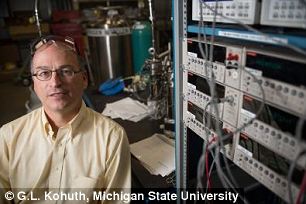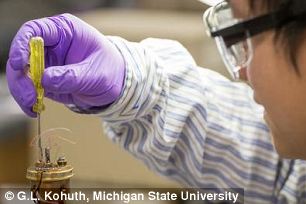
CHEAP MATERIAL MADE FROM DIRT CAN CONVERT HEAT DIRECTLY TO ELECTRICITY: NEW DISCOVERY COULD REVOLUTIONISE POWER GENERATION
Damien Gayle
- Thermoelectric material converts differences in temperature directly to electrical voltage
- It is not the first, but previous ones have been derived from rare and sometimes toxic elements via costly synthesis procedures
- Researchers say their discovery could pave the way for low-cost, environmentally friendly electricity generation
An incredible new material made from common dirt can take heat and directly convert it into an electrical current, a study claims.
Researchers say they produced the groundbreaking substance using commonly found materials and that it can be cheaply manufactured.
They believe the it could spark a revolution in eco-friendly power generation by taking waste heat from a range of common sources and converting it directly to electricity.

Raw material: The breakthrough new thermoelectric material is made from natural minerals called tetrahedrites which are found in dirt pretty much everywhere on the planet
So-called thermoelectric materials are able to directly convert differences in temperature to electrical voltage, and vice versa.
This are potentially important, scientists say, because the vast majority of heat that is generated from, for example, a car engine, is lost through the tail pipe.
It's the thermoelectric material's job to take that heat and turn it into something useful, like electricity.
Such materials have been made before, but previous examples have been derived from rare and sometimes toxic elements, often by way of expensive synthesis procedures.
Donald Morelli, a professor of chemical engineering and materials science at Michigan State University, led the team which developed the material based on natural minerals known as tetrahedrites.
'What we've managed to do is synthesize some compounds that have the same composition as natural minerals,' said Professor Morelli, director of MSU's Centre for Revolutionary Materials for Solid State Energy Conversion.
'The mineral family that they mimic is one of the most abundant minerals of this type on Earth – tetrahedrites.
'By modifying its composition in a very small way, we produced highly efficient thermoelectric materials.'


Groundbreaking: Professor Donald Morelli, left, led the team which developed the revolutionary material at Michigan State University's Centre for Revolutionary Materials for Solid State Energy Conversion, right
While the hunt for thermoelectric materials has exercised scientists across the world, with many recent breakthroughs, many of those found so far have been unsuitable for large-scale applications.
Many previous discoveries have been derived from rare or sometimes toxic elements, or produced using synthesis procedures are complex and costly.
'Typically you'd mine minerals, purify them into individual elements, and then recombine those elements into new compounds that you anticipate will have good thermoelectric properties,' said Professor Morelli.
'But that process costs a lot of money and takes a lot of time. Our method bypasses much of that.'
The MSU researchers' method involves the use of very common materials, grinding them to a powder, then using pressure and heat to compress into useable sizes.
'It saves tremendously in terms of processing costs,' Dr Morelli added.
The researchers expect this discovery could pave the way to many new, low-cost thermoelectric generation opportunities.
Potential applications include waste heat recovery from industrial power plants, conversion of vehicle exhaust gas heat into electricity, and generation of electricity in home-heating furnaces.
The research, supported by the U.S. Department of Energy, was published in the online journal Advanced Energy Materials.
